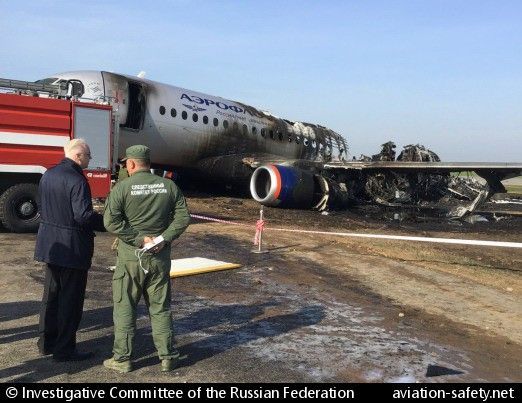ARFF Daily News
Published on:
Monday the 5th of May, 2025
Boeing 737-8K5 with 183 passengers forced into emergency landing at Findel
Claude Zeimetz, Roy Grotz, David Winter – adapted by RTL Today
On Saturday evening a flight from Birmingham to Dalaman, Turkey, carrying 183 passengers was forced into an emergency landing at Findel due to the concerning development of smoke in the cockpit and cabin.
The British Jet2 flight – on a Boeing 737–8K5 aircraft – carrying 183 passengers was forced to land at around 6.30pm on Saturday evening after smoke started entering the cockpit, Luxairport confirmed with RTL.
The smoke started in the cockpit and subsequently spread into the passenger cabin, prompting the immediate decision to divert and land urgently.
All 183 people on board were safely evacuated, and no injuries were reported, according to Alexander Flassak from Luxairport. Operations at Findel Airport were not affected by the incident, and flights continued to take off and land normally.
Jet2 is a low-cost UK airline operating routes between Britain and popular tourist destinations, including Saturday's flight to Dalaman in Turkey.
A replacement aircraft took passengers to their final destination in Dalaman on Saturday evening, while the emergency aircraft returned to Birmingham.
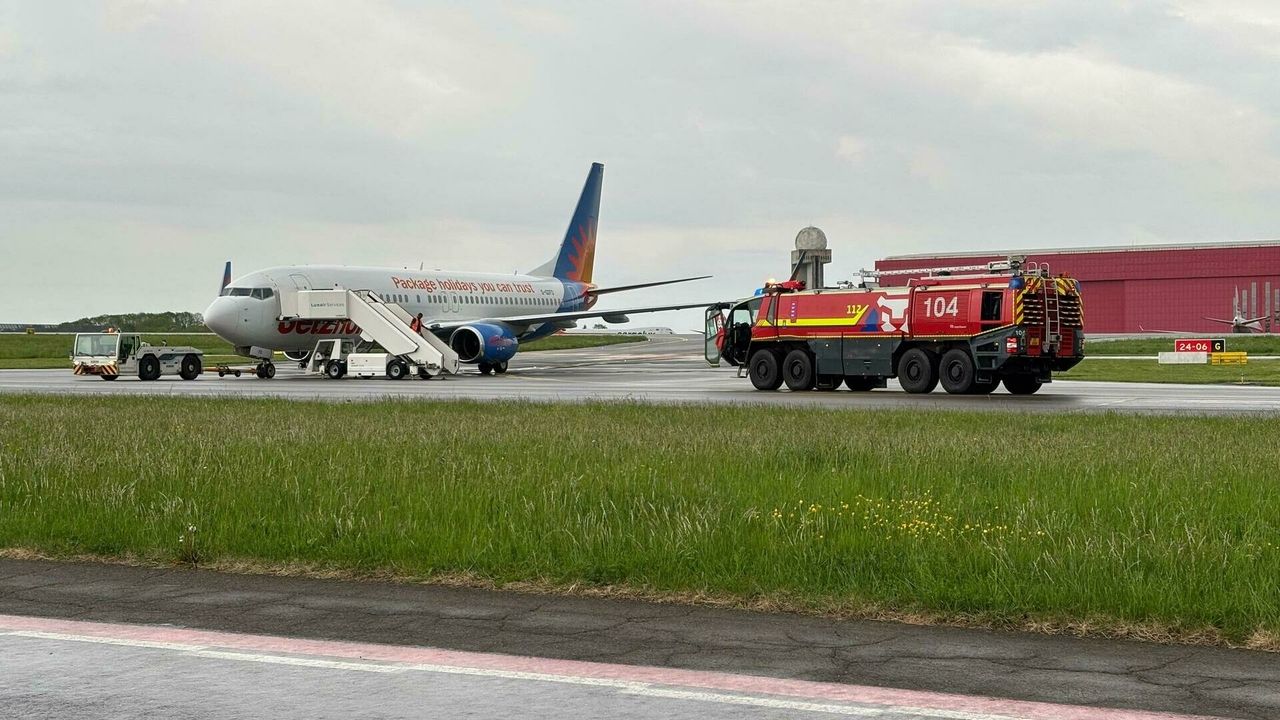
Man dead after seaplane flips during takeoff on Montreal's South Shore
Transportation Safety Board of Canada is investigating incident
CBC News
A man in his 50s is dead and another has minor injuries after a seaplane overturned during takeoff from the Richelieu River on Friday morning in the Montérégie region, located on Montreal's South Shore.
The incident occurred around 11 a.m. near Saint-Basile-le-Grand, about 30 kilometres east of downtown Montreal.
One of the men managed to escape the aircraft and swim to shore, suffering only minor injuries, according to the Sûreté du Québec (SQ).
The second man was trapped in the aircraft in the middle of the river.
Using boats, local firefighters from the Régie intermunicipale de sécurité incendie de la Vallée-du-Richelieu (RISIVR) rescued the second man by 2 p.m.
He was taken to hospital, where he was later pronounced dead, police said.
The aircraft was towed to shore.
The cause of the incident is not yet known, but the Transportation Safety Board of Canada (TSB) is investigating.
https://www.cbc.ca/news/canada/montreal/man-dead-plan-flips-1.7525421
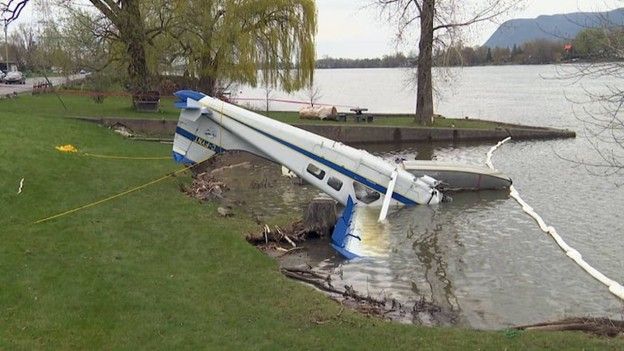
UPDATED: Small plane crashes in Simi Valley neighborhood; 2 dead
Staff reports - Ventura County Star
A small plane crashed into a Simi Valley neighborhood on the afternoon of May 3, authorities said, killing two people who were in the aircraft and hitting two homes that subsequently caught fire.
The pilot, a passenger and a dog in the aircraft died, the Simi Valley Police Department reported in the evening. The identities of the individuals were not reported pending notification of next of kin.
The accident took place around 1:51 p.m. in the 200 block of High Meadow Street, according to preliminary reports from the Ventura County Fire Department. The street cuts east from South Wood Ranch Parkway in the Wood Ranch area.
County Director of Airports Keith Freitas said he understands the plane departed from the General William J. Fox Airfield in Lancaster at 1:19 p.m. and was headed to the Camarillo Airport before the crash. "We believe it's an aircraft based at the Camarillo Airport," he said.
Initial callers had reported that a hillside was on fire along with a plane. Firefighters subsequently arrived and reported a plane into a structure with smoke showing, radio traffic indicated.
Simi Valley Police Department Sgt. Chris Johnson said officers found the small plane in the backyard of a residence.
The single-engine, fixed-wing aircraft crashed into two houses, according to Andrew Dowd, spokesman for the county fire department. Both are two-story single family homes.
Residents were inside both of the homes at the time and were evacuated. No one on the ground was injured, Dowd said. About 40 firefighters responded.
Both houses were impacted by fire and sustained structural damage, Dowd said. As of late afternoon, firefighters were still carrying out overhaul and salvage operations.
The plane was so badly damaged it was difficult to identify the wreckage as an aircraft, Dowd said.
Police officials said the department had received a report from the Point Mugu Air Traffic Control regarding a possible plane crash. The plane was not a military craft, authorities said. It was described by the National Transportation Safety Board as a Vans RV-10, which appears to be a kit-built aircraft.
The Federal Aviation Administration and the National Transportation Safety Board will take over the investigation, police officials said.
The police department advised motorists to avoid the area.
https://www.vcstar.com/story/news/local/2025/05/03/small-plane-reportedly-crashes-in-simi-valley/83433077007/

Man rescued after small plane loses engine power, crashes into Lake Ontario
By Bryann Aguilar and Joanna Lavoie
A pilot is now resting at home after being rescued from Lake Ontario on Friday afternoon when his small plane lost engine power and crashed off the shore of Tommy Thompson Park in the city’s east end.
Toronto police Duty Insp. Lhawang Jongdong said Billy Bishop Airport staff notified them just after 2 p.m. that they lost contact with an inbound aircraft. He said police also received multiple calls from witnesses who saw a plane having difficulty landing.
Emergency crews arrived to discover a small plane submerged and the pilot already out of the water with the help of nearby sailboaters.
Jongdong said the small privately owned aircraft had just taken off from the island airport and was on its way to Pembroke, Ont., for a medical call when it lost engine power.
When the 49-year-old pilot’s attempt to return to the Billy Bishop airport was unsuccessful, he deployed the aircraft’s parachute and hit the water shortly after, Jongdong said.
Images sent to CP24 show the moment the aircraft, with its parachute deployed, crashed into the waters of Lake Ontario.
“Upon landing in the water, nearby sailboaters obviously pulled the individual pilot off the water and then quickly transferred over to the Toronto Police Marine Unit,” he said.
Video taken by the sailboaters who came to the pilot’s rescue shows the aftermath of the crash with the plane sinking into Lake Ontario.
Paul Angus Bark was sailing with friends when they saw the plane hit the water at a “pretty hard angle.”
“The parachute suddenly came out, and we heard a bang, and then we saw it hit the water, so we just dropped sails, turned around, and headed straight to the plane,” Bark told CTV News Toronto.
“And then we got to it just as it sank. The pilot was only in the water for maybe a minute or two, but we pulled him out, and then we transferred him over.”
Jongdong said the pilot was assessed for minor injuries and has since gone home.
The duty inspector noted that Toronto police are liaising with Transportation Canada and the Ministry of Environment to ensure that there is no oil spill from the crash.
“As of now, it is fairly safe,” Jongdong said. “Also, we’ve notified the Coast Guard for navigational purposes to ensure that no boaters come in in that area.”
He expects the aircraft to be pulled out of the water sometime this weekend.
‘I saw and heard an explosion’
Downtown Toronto resident Doug Paulson was out for an e-bike ride in The Beaches area when he saw a small plane flying westbound between Ashbridges Bay and the Leslie Street Spit.
“Then, all of a sudden, I saw and heard an explosion,” he told CP24 on Friday evening, adding that several other cyclists, hikers, and people walking by quickly called 911 for help.
A hobby photographer, Paulson said he wasn’t able to snap a photo of that exact moment, but quickly grabbed his camera, which he said was outfitted with a long lens, and started taking pictures of aircraft crash landing into Lake Ontario.
Paulson, who is also a retired pilot, said as the plane slowly descended, a large parachute was released from its rear.
The aircraft then hit the water, he said, but appeared to be held up for a time by the wind, which Paulson said likely gave the pilot enough time to crawl out and sit on its nose.
He told CP24 that he’s been in communication with some of his aviation contacts, who have told him that the wreckage of the plane has now sunk about 40 feet.
Paulson added that the aircraft would need to be retrieved by a salvage crew so that the Transportation Safety Board of Canada could determine exactly what had happened.
“I’m very curious about what was that explosion,” said Paulson, who is also a voice actor.
Parachute helped minimized damage: expert
Duty Insp. Jongdong confirmed that the plane involved was a Cirrus aircraft, which is currently the only light plane equipped with a parachute system.
Phyl Durdey, CTV News’ aviation specialist, told CP24 that the parachute is the aircraft’s ballistic recovery system, which is usually attached to the back.
“If the aircraft has an engine failure or is in distress, what they can do is they can pop, they can pull the handle in the cockpit and deploy the parachute, and it brings the aircraft down, floats it down safely to the ground,” Durdey said.
“Having that ballistic parachute deployed, it helps him land anywhere and land safely.”
Durdey credited the recovery parachute system, which he described as “second to none,” for helping minimize the damage that the plane would have sustained when it hit the water.
“It can save a lot of lives, and it’s a good piece of equipment to have on the aircraft,” Durdey said.
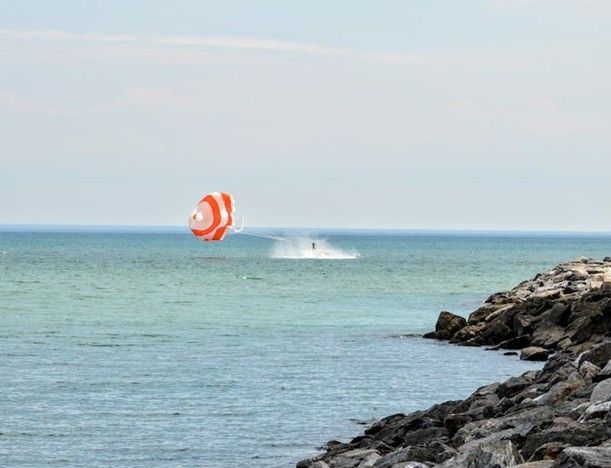
Small plane crashes north of Kentwood
By Jesse Brooks
NEW ORLEANS (WVUE) - The Tangipahoa Parish Sheriff’s Office reports that a small plane crashed Saturday (May 3) north of Kentwood.
The sheriff’s office said there were two passengers aboard, a man and a woman. The man was sent to a local hospital for moderate to severe injuries, and the woman had minor injuries.
The plane crashed in an area near B. Sanders Road.
https://www.fox8live.com/2025/05/03/small-plane-crashes-north-kentwood/
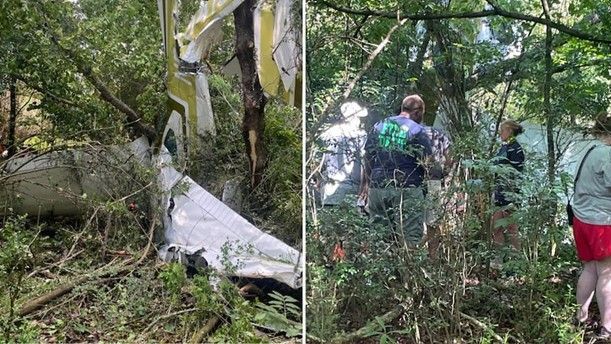
77-year-old man killed in small plane crash in rural Ellsworth County
By KWCH Staff and Dylan Domangue
ELLSWORTH COUNTY, Kan. (KWCH) - UPDATE: One person was killed after a small plane crash Sunday afternoon in rural Ellsworth County near the town of Wilson.
According to the Kansas Highway Patrol crash logs, 77-year-old Ronnie Thompson was flying from Lucas in Russell County back to Wichita when a witness states the plane went down for no apparent reason.
The NTSB, FAA and KHP are all investigating the crash.
Investigators with the Kansas Highway Patrol and National Transportation Safety Board are investigation a small plane crash in rural Ellsworth County on Sunday.
The KHP says the crash occurred around 1:30 p.m. Sunday afternoon near the intersection of Avenue D and 4th Rd. The plane crash was near the town of Wilson.
When troopers arrived on scene, they found a Piper J3C-65 plane upside down.
The NTSB and KHP could not confirm any injuries or how many people were on the plane at the time of the crash.
https://www.kwch.com/2025/05/04/ntsb-kansas-highway-patrol-investigating-small-plane-crash-rural-ellsworth-county/
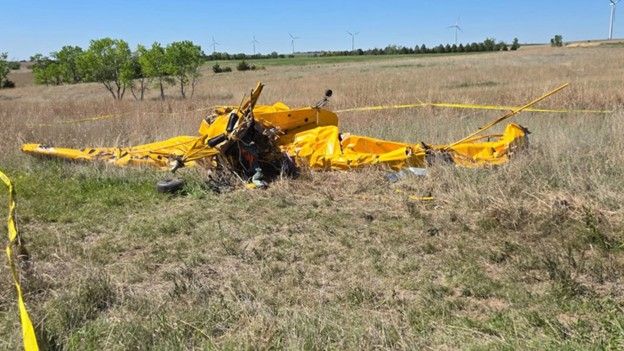
NTSB Prelim: De Havilland DHC-1
At Altitude Of About 250-300 Ft Agl, The Airplane Experienced A Total Loss Of Engine Power
Location: East Troy, WI Accident Number: CEN25LA035
Date & Time: November 6, 2024, 15:55 Local Registration: N420TD
Aircraft: De Havilland DHC-1 Injuries: 1 Minor
Flight Conducted Under: Part 91: General aviation - Personal
On November 6, 2024, at 1600 central standard time, a De Havilland DHC-1, N420TD, was involved in an accident near East Troy, Wisconsin. The airplane sustained substantial damage. The private pilot received minor injuries. The airplane was operated under Title 14 Code of Federal Regulations Part 91 as a personal flight.
The pilot stated that during preflight of the airplane for the personal flight, there was 3 gal of fuel in the left wing tank and 4 gal of fuel in the right wing tank. He stated the airplane had a fuel capacity of 9 gal in each wing tank. He departed and performed one touch and go landing at the departure airport and then flew about 3 mi west where he performed two steep turns. He stated that during the flight’s return to the departure airport, the left wing tank fuel gauge indicated 2 gal and the right wing tank fuel gauge indicated 3 gal while the airplane was on the downwind leg for landing. About ½ way down the final approach leg for landing and at altitude of about 250-300 ft agl, the airplane experienced a total loss of engine power.
The pilot changed the fuel tank selection, but the engine did not regain power. The pilot performed a forced landing and landed about 300-400 ft short of the runway. The airplane sustained substantial damage to the wings and fuselage.
Postaccident examination of the airplane revealed that the left wing fuel tank contained no fuel and the right wing fuel tank contained an estimated 2/3 gal of fuel. There was no fuel within the fuel system downstream of the wing fuel tanks.
The airplane was retained for further examination.
FMI: www.ntsb.gov
NTSB Prelim: Christopher Randall Raptor Junior 540
Pilot Attempted To Restore Electrical And Engine Power, However, Was Unsuccessful
Location: Camarillo, CA Accident Number: WPR24LA081
Date & Time: January 30, 2024, 13:17 Local Registration: N906CR
Aircraft: Christopher Randall Raptor Junior 540 Injuries: 1 Serious, 1 Minor
Flight Conducted Under: Part 91: General aviation - Personal
On January 30, 2024, about 1317 Pacific standard time, an experimental amateur-built Raptor Junior 540, N906CR, was substantially damaged when it was involved in an accident near Camarillo, California. The pilot received serious injuries and the pilot-rated passenger received minor injuries. The airplane was operated as a Title 14 Code of Federal Regulations Part 91 personal flight.
According to the pilot, he and his pilot-rated passenger had departed Santa Monica Municipal Airport, Santa Monica, California, and were enroute to the Camarillo Airport (CMA), Camarillo, California, to conduct touch and go landings. Approximately 5 miles southeast of CMA, the pilot noticed a warning indication from the airplane’s avionics display alerting him to a loss of electrical power. He stated that within seconds, all electrical avionics with the exception of the primary flight display, “went blank” followed by a total loss of engine power. The pilot attempted to restore electrical and engine power, however, was unsuccessful. He initiated a forced landing to a field approximately 4.5 miles southeast of CMA. During the forced landing, the airplane struck terrain and came to rest upright.
Postaccident examination of the airplane revealed that the fuselage, canards, and both wings sustained substantial damage. The airplane was recovered to a secure facility for further examination.
FMI: www.ntsb.gov
NTSB Prelim: Azalea Aviation LLC Saberwing
One Witness Saw The Airplane Spin About One And A Half Revolutions Before It Descended Out Of Their Sight
Location: Justin, TX Accident Number: WPR25FA127
Date & Time: April 11, 2025, 19:06 Local Registration: N121DF
Aircraft: Azalea Aviation LLC Saberwing Injuries: 1 Fatal
Flight Conducted Under: Part 91: General aviation - Personal
On April 11, 2025, about 1906 central daylight time (CDT), an experimental amateur-built Azalea Aviation LLC Saberwing, N121DF, was destroyed when it was involved in an accident near Justin, Texas. The pilot was fatally injured. The airplane was operated as a Title 14 Code of Federal Regulations Part 91 personal flight.
According to the airframe kit manufacturer, the pilot was returning to Propwash Airport (16X), Justin, Texas. He departed the Valdosta Regional Airport (VLD) Valdosta, Georgia about 1120 eastern daylight time, with a stop at the Ralph C. Weiser Field Airport (AGO) Magnolia, Arkansas. ADS-B data showed that the airplane arrived at AGO about 1621 CDT. About that time, the manufacturer received a text from the pilot who informed him that he arrived at AGO, needed fuel, all was running well, and that he would try to make it home today.
Preliminary ADS-B data showed the airplane depart AGO about 1705 CDT and ascended to 4,300 ft mean sea level (msl) on a westerly heading toward 16X. About 1900 CDT the flight track data showed the airplane descended from 2,275 ft to about 1,250 ft and made a series of maneuvers and altitude changes that were consistent with entering the airport traffic pattern. A witness, located at the airport, described seeing the airplane while it was on the downwind leg for runway 35 at a low altitude when it made the base leg turn. Witnesses located in a housing community about 0.6 miles south of the airport saw the airplane heading south, turn left, when the left wing dropped, and the airplane turned upside down. One witness saw the airplane spin about one and a half revolutions before it descended out of their sight behind a house. No witnesses reported seeing the airplane impact the terrain.
The airplane came to rest upright in an open field, about .5 miles southwest of the threshold for runway 35, on a heading of 200° magnetic, and an elevation of about 762 ft msl. The first point of impact was directly underneath the engine which was embedded in the soil about ten inches. A postaccident fire consumed most of the airframe. All major components of the airplane remained adjacent to the fuselage except for the upper structure of the left wing and portions of the fractured canopy, which were located near the main wreckage. A small debris area extended about 30 ft around the wreckage.
The wreckage was recovered to a secure facility for further examination.
FMI: www.ntsb.gov

Today in History
6 Years ago today: On 5 May 2019 Aeroflot flight 1492, a Sukhoi Superjet, returned to land at Moscow's Sheremetyevo Airport in Russia and burst into flames during an attempted emergency landing. Of the 78 persons on board, 41 did not survive.
Date: Sunday 5 May 2019
Time: 18:30
Type: Sukhoi Superjet 100-95B
Owner/operator: Aeroflot Russian International Airlines
Registration: RA-89098
MSN: 95135
Year of manufacture: 2017
Total airframe hrs: 2710 hours
Cycles: 1658 flights
Engine model: PowerJet SaM146
Fatalities: Fatalities: 41 / Occupants: 78
Other fatalities: 0
Aircraft damage: Destroyed, written off
Category: Accident
Location: Moskva-Sheremetyevo Airport (SVO) - Russia
Phase: Landing
Nature: Passenger - Scheduled
Departure airport: Moskva-Sheremetyevo Airport (SVO/UUEE)
Destination airport: Murmansk Airport (MMK/ULMM)
Investigating agency: MAK
Confidence Rating: Accident investigation report completed and information captured
Narrative:
Aeroflot flight 1492, a Sukhoi Superjet, returned to land at Moscow's Sheremetyevo Airport in Russia and burst into flames during an attempted emergency landing. Of the 78 persons on board, 41 did not survive.
The aircraft took off from Sheremetyevo Airport's runway 24C at 18:03 hours local time on a scheduled service to Murmansk, Russia. Visibility was fine but there were some Cumulonimbus clouds near the airfield at 6000 feet.
The flight crew engaged the autopilot as the aircraft climbed through a height of 700 ft (215 m). At 18:08, as the aircraft was climbing through an altitude of about 8900 ft (2700 m), a failure occurred in the electrical system. At this point, the aircraft was 30 km west-northwest of the airport in an area of thunderstorm activity.
The captain assumed manual control of the aircraft and the crew managed to establish radio contact using UHF. The flight was not able to contact the approach controller and subsequently selected the emergency transponder code 7600 (loss of radio communication).
About 18:17 the aircraft overshot the runway centreline after turning to runway heading. Altitude at that time was about 2400 feet. The aircraft continued the right-hand turn, completed a circle and proceeded on the final approach for runway 24L. Flaps were selected at 25°, which was the recommended setting for landing above maximum landing weight.
At 18:26 the flight crew selected the emergency transponder code 7700 (emergency).
When descending from 335 to 275 m (1100-900 ft) the windshear warning system sounded five times: "Go around. Windshear ahead".
From a height of 80 m (260 ft) above ground level, the aircraft descended below the glide path and at a height of 55 m (180 ft) the TAWS warning sounded: "Glide Slope." From that moment on the airspeed increased to 170 knots.
At 18:30 the aircraft overflew the runway threshold and touched down at a distance of 900 m past the threshold at a speed of 158 knots. Touchdown occurred at a g-force of at least 2.55g with a subsequent bounce to a height of about 2 m. After two seconds the aircraft landed again on the nose landing gear with a vertical load 5.85g, and bounced to a height of 6 m. The third landing of the aircraft occurred at a speed of 140 knots with a vertical overload of at least 5g. This caused a rupture of the wing structure and fuel lines. Flames erupted and engulfed the rear of the aircraft. The aircraft slid to a stop on the grass between runway 24L and two taxiways. An emergency evacuation was then carried out while flames quickly engulfed the rear fuselage.
Conclusion
The cause of the aviation accident involving the RRJ-95B aircraft (registration RA-89098) was the uncoordinated control inputs by the captain during the flare phase of landing and during the repeated bounces of the aircraft off the runway (“porpoising”), which were characterized by multiple, disproportionate, alternating movements of the control stick, with it being held at extreme positions. These control actions led to three hard landings, and during the second and third landings, the absorbed energy levels significantly exceeded the maximum values considered during the aircraft type certification strength assessment. This resulted in the destruction of structural load-bearing elements of the airframe, rupture of fuel tanks with fuel spillage, and the outbreak of a fire.
Contributing factors included:
- Ineffectiveness of the approved pilot training programs for the RRJ-95 in handling special (complex) situations when the flight control system (FCS) switched to 'DIRECT MODE', leading to insufficient knowledge and skills of the crew to operate the aircraft in this mode. While the training programs met the minimum requirements of the Federal Aviation Rules (FAR), they did not address the specifics of such a situation.
- Ineffectiveness of the airline's flight operations quality assurance (FOQA) system in ensuring pilots developed stable piloting skills. This failed to identify and correct the captain’s systematic errors in longitudinal control using the side-stick during landing, including pushing the side-stick forward beyond the neutral position during flare.
- Failure to detect deviations (hazard factors) in piloting techniques in previous instances of FCS transitions to DIRECT MODE, and hence, no preventive measures were taken.
- Vague language in the aircraft's operational documentation regarding piloting techniques during flare and correction of deviations during landing (e.g., bounce handling).
- Non-compliance by the crew with FAR and Flight Operations Manual (FOM) requirements during flight preparation and execution, despite forecasted and observed thunderstorm activity and the presence of such weather zones on the weather radar. This led to the aircraft being struck by atmospheric electricity, causing data concentrator reboots and the FCS switching to DIRECT MODE. The FCS switch to DIRECT MODE due to lightning or static electricity was considered a “complex situation” during certification and complies with certification requirements.
- Significant increase in the captain’s psycho-emotional stress after the lightning strike and his prolonged inability to maintain acceptable flight precision in DIRECT MODE, leading to a psychological fixation on making an “urgent” landing and an unwillingness to perform a go-around.
- Personal psychological traits of the crew members affecting their behavior under stress, along with insufficient training of the captain in human factors and threat/error management. This prevented him from objectively assessing his mental state and ability to control the aircraft, choosing the best flight continuation strategy, and managing crew coordination and resource management effectively.
- The captain’s inability to manually trim the aircraft in the longitudinal axis, including during glide path descent.
- Incorrect crew assessment of a predictive wind shear alert (GO AROUND, W/S AHEAD) while on final approach, resulting in a failure to initiate a go-around. This led to encountering a microburst after the flare began, affecting the aircraft’s trajectory. Aircraft and airline documentation allow ignoring this alert if the crew is convinced there is “no wind shear threat,” but there are no clear criteria for this in operational documents or the FOM.
- The captain’s intentional descent below the glide path during the final approach (after passing decision height).
- Discrepancies between the airline’s FOM and the aircraft manufacturer’s documentation regarding actions to take when deviation from the glide path occurs. If the manufacturer's instructions had been followed, a go-around would have been required. The airline unjustifiably widened the stabilization criteria for approach, particularly regarding allowable speed deviations. The actual indicated airspeed exceeded the target by more than 15 knots, and in DIRECT MODE, this caused an unexpectedly strong pitch response to side-stick input.
- The crew’s failure to follow the standard procedure for manual deployment of air brakes during landing. The vague wording in the documentation and the configuration logic requiring pre-arming of air brakes for automatic deployment — even though automation is not available in DIRECT MODE — reduced crew situational awareness.
- Activation of reverse thrust after the first bounce, which made it impossible to perform a subsequent go-around.
According to forensic medical examinations, the cause of death for 40 out of 41 victims was exposure to open flame, accompanied by burns to the upper respiratory tract due to inhalation of hot air.
The fire began after the aircraft’s third impact with the runway due to the destruction of wing fuel tanks and fuel spillage. Fuel leaked both from the landing gear actuator mount areas and other wing sections. The landing gear was damaged during the second landing, and by the third impact, it was operating beyond design limits and couldn’t properly absorb landing loads.
The collapse (failure) of the "weak links" in the landing gear during the second landing functioned as designed. The actual loads experienced were below those used to demonstrate compliance with section 25.721 of FAR-25 during certification, which meant that the main gear was only partially separated from the airframe — only the “weak link” elements at point “A” were destroyed.
There is a lack of correlation between certification requirements for structural strength — including the main landing gear supports — and those for demonstrating safe separation, which results in substantial risk of fuel tank rupture and fuel leakage even when meeting both sets of requirements separately.
At the onset, the fire was a deflagration flash, accompanied by intense smoke, and transitioned to sustained burning within two seconds. By the time passenger evacuation began, the fire had already penetrated the cabin through several windows in the aft fuselage on both sides. Airworthiness standards do not require windows to provide fire resistance from external sources. The situation exceeded expected operational conditions due to the absence of the standard 90-second window used to demonstrate evacuation capability during certification.
Factors most likely contributing to the severity of the consequences included:
- Engines still operating, not shut down promptly by the crew;
- Large volume of fuel leaking from both wing consoles, entering the area of the engine exhaust nozzles and exposed to jet blast;
- Inability to use both rear exits for evacuation;
- “Flashover” effect in the rear of the cabin;
- Passenger stampede and panic;
- Some passengers attempting to retrieve hand luggage during evacuation;
- Error by the lead flight attendant in using the public address system, resulting in reduced passenger awareness about the evacuation process.
A fire development model by the St. Petersburg University of the State Fire Service of the Ministry of Emergency Situations (EMERCOM) showed that the flight attendant's mistaken decision to open the rear left door under the actual circumstances did not increase the fire’s damaging effects and did not influence the severity of the accident's consequences.
